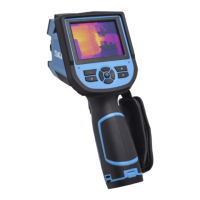22
SKF TKTI 21 & 31
4.3.3 Emissivity
Different surfaces can radiate different amounts of infrared energy at the same
temperature. This difference in temperature measurement can be corrected by setting the
emissivity value.
The amount of infrared radiation emitted by a surface depends on both its temperature
and its emissivity. Surfaces that are good reflectors (e.g. polished metal) are poor emitters,
and surfaces that are good emitters (e.g. human skin) are poor reflectors. A black body
is defined as an object that absorbs all the radiations falling on it and it is also a perfect
emitter of radiation.
The emissivity of a surface (usually written ε) is the ratio of the energy radiated by that
surface to the energy radiated by a black body at the same temperature. For accurate
temperature measurements, the emissivity of the surface being measured must be
entered into the camera. This is done by entering a number in the range from 0.10
(for polished chromium) to 1.00 (for a black body). An emissivity lookup table is provided,
which lists the emissivities of a range of common materials. It is not recommended to use
the camera on surfaces with an emissivity below 0.7.
The global emissivity can be set via the Adjustment menu.
Select Setup->Adjustment to open the Adjustment dialog box.
Figure 23 Emissivity adjustment
The user can set the global emissivity, temperature correct and ambient temperature.
• Emissivity: The emissivity can be entered manually or chosen from a list of materials
by clicking on Customize. See a list of common emissivities in chapter 6.2.
• TCorrect: Temperature correction setup.
• TReflect: Some of the infrared energy seen by the camera is reflected by the
background. If there is a hot object in the background, this can have a significant
effect on the temperature measured. By entering a reflected temperature value,
the camera can correct for the effect of this reflected background energy.
Usually set to the ambient temperature.
The emissivity of each cursor, area or line can also be individually adjusted after these
elements have been created (see 3.4.2 A button)

